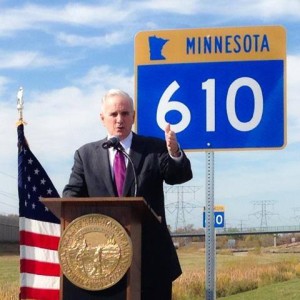Governor Mark Dayton and Transportation Commissioner Charlie Zelle this week released a detailed list of more than 600 road and bridge improvements that would be completed if the Legislature passes the Governor’s proposed investments in transportation. The comprehensive list, sorted by county, details the more than 2,200 miles of state roadways and 330 bridges that would be repaired, replaced, or expanded over the next ten years under the Governor’s proposal.
Included is the expansion of Interstate 94 to six lanes between St. Michael and Albertville, a six-mile stretch of road that adds on to the 2015 project expanding the interstate system from Rogers to St. Michael, and a much-needed change according to local and regional leaders.

Minnesota Gov. Mark Dayton speaks at the groundbreaking for Minnesota Highway 610 last fall near Maple Grove. The governor’s new transportation plan calls for expansion of the Interstate 94 corridor through Albertville.
Additional funding is put in place for road rehabilitation and repair from Monticello to Clearwater, along I-94, or between the Highway 25 and Highway 24 exits. What’s not included in that stretch is lane expansion, according to the governor’s outline. That falls short of the I-94 Coalition’s hope, backed by state legislators such as Reps. Eric Lucero and Marion O’Neil, as well as Sen. Mary Kiffmeyer, to get the freeway expansion through Wright County and on its way up to St. Cloud.
Still, the interstate work targeted by Dayton is more aggressive than recent proposals by the Minnesota Department of Transportation (MnDOT), which didn’t have I-94 expansion on its timeline until beyond 2018.
“Minnesotans rely on these roads and bridges every day to get to work, bring their kids to school, and get their goods to market,” Dayton said. “If we fail to act, the condition of these roads and bridges will only get worse. I urge all Minnesotans to review this list of projects and decide for themselves whether these investments are worth making.”
Road and bridge improvements funded by the governor’s proposal are needed, according to state officials. Right now, more than half of Minnesota’s roads are more than 50 years old, and 40 percent of the state’s bridges are more than 40 years old. In just the next three years alone, one in five Minnesota roads will pass their useful life. And in the next 10 years, nearly 40 percent of our roads will be past their useful life.
“After decades of decline, Governor Dayton’s transportation proposal would make needed investments in roads and bridges across Minnesota,” Zelle said. “The governor’s proposal would help reduce travel times, improve safety, and build a modern transportation system that would meet the needs of our state’s growing population and economy.”
Projects included in the list released today are based on MnDOT recommendations. In selecting pavement and bridge improvements, MnDOT gave priority to projects that would extend the life of roadways and bridges beyond the current 20-year State Highway Investment Plan (MnSHIP). MnDOT used the following criteria to select the projects included in the list released today:
- Fixing Roads in Urgent Need of Repair – Priority was given to projects that would reduce the total miles of roadway statewide that have no remaining service life (meaning they are in very poor condition, and in need of repair). Over the next 10 years, roughly 4,370 miles of roadway on the state system will have zero remaining service life.
- Making Longer-Term Fixes on Currently-Planned Projects – Instead of just making temporary fixes that would need to be repaired again in just a few years, this list of projects includes upgrades of currently-planned projects to make sure those repairs last longer, and would extend the useful life of more Minnesota roadways.
- Preventing Problems Before They Happen – Projects were included in the list released today that would provide for preventive maintenance that would reduce the need to do longer-term work in the near future. By preventing further deterioration, these new investments would forego the need to perform costlier fixes down the road.
- Strategic Expansion – The list also includes projects that make targeted investments in key freight routes across Minnesota that are important for business expansions, job creation, and economic development.
The list of projects released Tuesday, Feb. 17 includes $1.6 billion in Corridors of Commerce funding that would be provided under the governor’s proposal. These funds would be used specifically on projects that would strengthen Minnesota’s transportation system by adding capacity, reducing congestion, and improving the movement of freight across Minnesota, such as the 94 expansion currently underway between Rogers and St. Michael.
Local road improvement projects – funded with help from the state, but chosen by local governments – are not included on this list. However, more than 40 percent of the new revenue raised in the governor’s proposed transportation budget ($2.356 billion) would be directed to cities, counties, and townships, the governor’s office stated.
About the Transportation Proposal
Several weeks ago, Governor Dayton proposed his 2015 transportation budget for the next biennium, aimed at fixing Minnesota’s aging transportation systems. The plan would invest $6 billion over the next 10 years to address the state’s highway funding deficit, invest $2.356 billion in local government transportation projects, and provide $2.92 billion for Metro and Greater Minnesota transit systems.
To learn more about his proposal, click on the links below:
List of Projects – Review the list of projects – released today by the Governor and MnDOT – that would be completed over the next 10 years if the Governor’s transportation proposal is passed
How it Works – Read about how the plan would be funded
Fact Sheet – The governor’s office compiled its list of challenges facing the state’s transportation system, and how Dayton’s proposed investments would address those challenges
Local Funding Increases – Learn how much funding each city and county would receive under the proposal
Maps – Take a look at the transportation projects that would be funded, by region